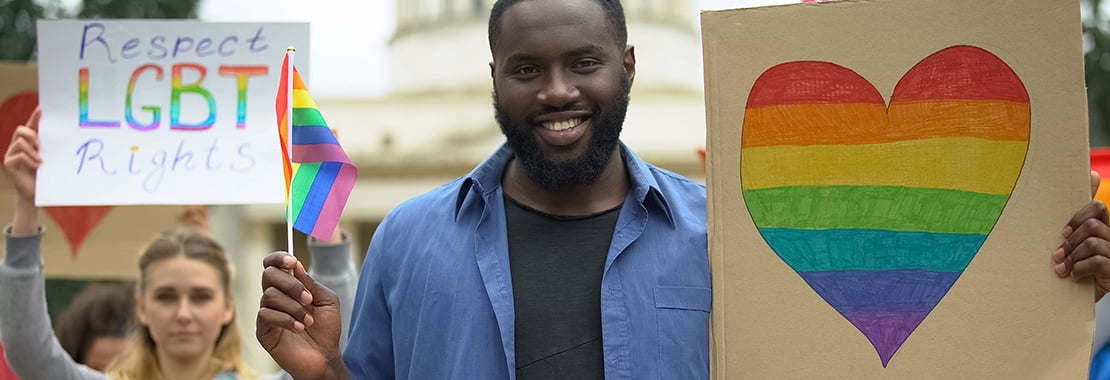Leslie Driscoll is a freelance copywriter and proud member of the LGBTQIA+ community.
Pride month often brings to mind parades with extravagant floats and festive onlookers—illustrating a stark change from its roots as a civil rights movement. But for those looking beyond the now-typical Pride bash, groups like the Stonewall Contingent and the Reclaim Pride Coalition can be found organizing marches, harking back to Pride’s origins.
With the various turbulent events of 2020—from COVID-19 to the tragic deaths of George Floyd, Breonna Taylor and others—your LGBTQIA+ students may be reflecting on the initial goals behind Pride. This year especially presents an opportunity to honor activists like Marsha P. Johnson and other historical icons who, in the 1969 Stonewall Riots, took a stand against harmful laws and practices that perpetuated the mistreatment of LGBTQIA+ community members.
While many LGBTQIA+ students feel that the climate on their college campus is better than they experienced in high school, more than half still report feeling unsafe at school due to their sexual orientation. Taking time in your classroom to acknowledge students’ varied experiences within the LGBTQIA+ community can help them feel especially empowered to succeed—even as institutions currently require classes to be online.
By taking advantage of classroom exercises, resource lists and other methods, you can make your classroom even more inclusive during Pride month—and every month.
Explore Pride from Past to Present
This year presented its share of challenges globally and within the United States. Showing students how far the modern LGBTQIA+ movement has come since its landmark protests can help students understand the importance of today’s Black Lives Matter protests. Exploring this discussion, students can see how demands for social justice have historically—and presently—catalyzed more equitable social policies, from Stonewall’s inception as the 51-year-long push for LGBTQIA+ rights to four officers being charged for police brutality in 2020.
At a time when news cycles are rife with distressing headlines, taking a moment to discuss what’s going on can provide your students with a platform to share their thoughts and experiences while thinking critically about current events. During these discussions, it’s especially important to give the floor to the LGBTQIA+ community as well as students of color, students with disabilities, students of different nationalities and other marginalized groups.
Need a lesson prompt? Here are some podcasts and articles that can get you started:
- 5 Podcasts at the Intersection of Pride Month and the Black Lives Matter Movement
- LGBTQ Inclusive ‘All Black Lives Matter’ March To Take Place In LA
- The History Of Pride Month And What It Can Teach Us About Moving Forward Today
- What the 2020 Black Lives Matter protests have achieved so far
Be an Ally
Many students, those from Gen Z in particular, are feeling the damaging mental health effects of this year’s current events. Fortunately, there are various ways you can offer students relief as they grapple with quarantine-related loneliness, worries about online classes, a possible financial recession, how to fight racism and other issues of today. Even something as simple as displaying the rainbow logo in your classroom can help students feel supported—and with courses across the country going online, there are digital ways to go about it!
Regardless of what discipline you teach, weaving Pride into an existing lesson plan can create a dynamic opportunity for students to capture lessons they can relate to. Since Pride is so personally integral to many students, there is ample opportunity for them to apply your concepts to their real-life scenario. According to this ebook on boosting student learning, “as students build knowledge and skills around tasks that have relevance to their own lives, they not only accelerate academic skills but they learn to advocate for themselves and others.”
You can let students know you’re someone to lean on by keeping the following lists available in your course:
- Housing and food resources. Fourteen percent of students reported being homeless in 2020. Since homelessness disproportionately affects members of the LGBTQIA+ community, making this list known can show your support for the living conditions and safety of your students.
- Professional networking opportunities for LGBTQIA+ students. Knowing the names of specific events or groups that enable students to network with professionals in their community can give them the confidence to find meaningful employment where they feel safe being themselves.
- Resources specifically for students of color. In what’s known as “multiple minority stress,” non-white members of the LGBTQIA+ community are subject to more types of oppression than their white counterparts. Here is just one list of resources that specifically addresses the unique needs for this community.
- LGBTQIA+ resources at your school. Find out about groups, protections and other ways your institution is committed to supporting students.
- Expectations for managing in-class safety of LGBTQIA+ students. Make it known that hate speech, microaggressions and other harmful actions won’t be tolerated in your class. Provide examples and discuss these rules in class as needed.
- Methods and times to contact you. If you’re able to be a resource, offer ways to personally be there for any student facing discrimination and other stressors related to their identity.
Making these lists known in the beginning of the semester, and providing ways for students to access them online, show that any struggles they may face as members of the LGBTQIA+ community are less likely to be barriers to their success in your course.
Your Care Builds Their Confidence
When LGBTQIA+ individuals are given a platform in your classroom, you inspire them to bring their voice into other spaces. During uncertain times, this confidence can help students of various sexualities and genders feel empowered to excel in your class and beyond. Now that’s student engagement you can be proud of.
Find more tips on building student confidence in your course.

